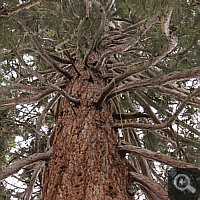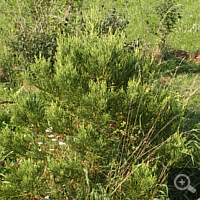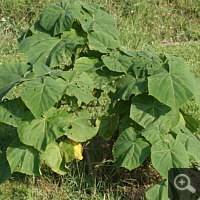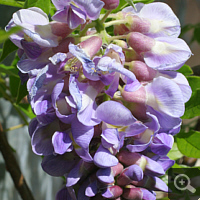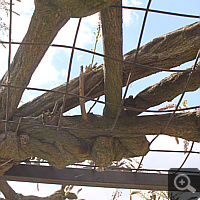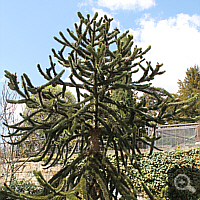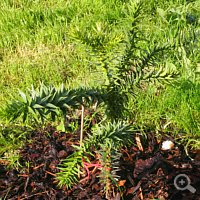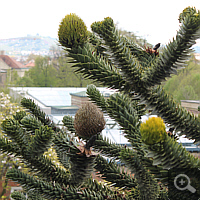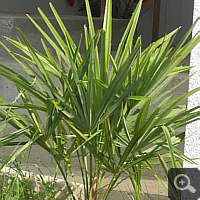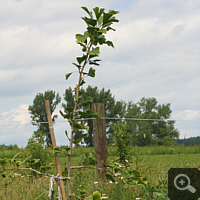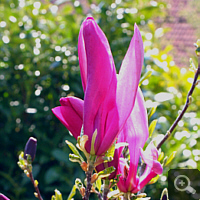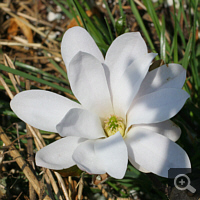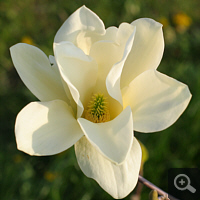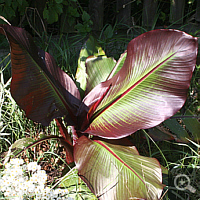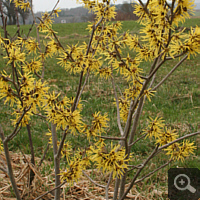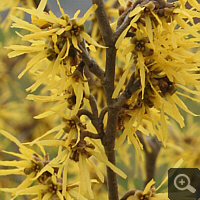
Hardy Exotic Plants
The natural distribution of the Giant Sequoia is only a small area in California in the region of the Sierra Nevada western slopes. Because there predominates snowy winter, the tree is also in Germany completely hardy. By volume, the Giant Sequoia is considered as the greatest on earth ever existing tree. Already the height of the tree is with almost 100 metres imposing and is only outreached by the Coastal Sequoia (Sequoia sempervirens). Both monotypic genera belong to the Cypress family (Cupressaceae). However, I find trunk circumference substantially more impressive than height. This is in the case of older exemplars over 30 m at a diameter of circa 9 metres. Giant Sequoias are getting very old (up to 3000 years) and should have a growth period of circa 500 years. In the first 100 years a Giant Sequoia grows up to a height of circa 30 m, so that it fits doubtless in each great garden.
Characteristical for the Giant Sequoia is the deep, reddish bark, extremely short needles, which cover the branch rather squamous, and the only a few centimetres great cones with tiny seeds. First the Giant Sequoia is growing rather slimly, later pyramidally. Only in old age the Giant Sequoia shows its maverick, typical growth, which came about amongst other things by the influences of forest fires, storms and lightning strikes in the course of centuries.
Today the Giant Sequoia is in Germany in numerous tree nurseries and market gardens available. You plant it in sunny to half-shady location, an occasionally fertilisation with a conifers fertilizer gets the Giant Sequoia well. A pruning is not necessary, nor a winter protection.
The Empress Tree come from Central China and belongs to the Empress Tree family (Paulowniaceae). The Empress Tree is a rather extraordinary rarity, as one of the very few trees it produces strikingly great and blue blossoms in spring. The single flower has a size of circa 5 cm, is campanulate and stands together in circa 40 cm large racemes, which appear still before the leaf budding in April or May. Especially in the youth Empress Trees are very fast-growing and produce up to 45 cm great, cordate leaves. Unfortunately is the Empress Tree as young plant frost-sensitive and needs a winter protection. However, young Empress Trees more than compensate in spring frost damage by their strong growth. With advancing age the tree grows slower, the leaves remain smaller and frost tolerance increases distinctly. Larger specimens are rated as fully hardy. Maximum height is circa 15 metres. You should choose as location a sunny, protected from the wind site with a nutrient-rich soil.
The poisonous Chinese Wisteria is a member of the Legume family (Fabaceae). The Chinese Wisteria is a woody, up to 30 m long creeper with odd-pinnate leaves and very attractive, blue racemes, which appear before leaf budding in spring. A second, less strongly blossom takes mostly place in summer.
The Chinese Wisteria is a fast-growing, beautiful facade greenery, that delights with its splendid and lavish blossom. Nevertheless is the usage of Chinese Wisterias not unproblematic, because it has a substantial potency as building stock ravager. Older plants develope undreamed-of strengths and have the ability to raise roofing tiles, to constrict downspouts or to rip climbing trellis and tensioned ropes from their moorings. Thus, the Chinese Wisteria should be kept in sufficient distance from the building stock and must be pruned annually.
To master successfully the split between delicacy and secrurity, I proceed in the following way:
Initially
 Initially several, strong shoots are coiled separately around a tensioned rope. Sideshoots are periodically pruned to a length of circa 20 cm. Over time main shoots lignify and become thicker. When main shoots have reached the desired height, these are passed on horizontally.
Initially several, strong shoots are coiled separately around a tensioned rope. Sideshoots are periodically pruned to a length of circa 20 cm. Over time main shoots lignify and become thicker. When main shoots have reached the desired height, these are passed on horizontally.
Afterwards
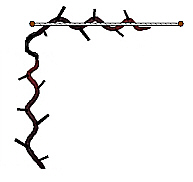 As soon as a main shoot has reached a sufficient height for a horizontal redirection, horizontal is also a tieing assistance (e.g. a tensioned rope) installed and the vertical running rope is now removed. At the horizontal guide the shoot is now tied best from below.
As soon as a main shoot has reached a sufficient height for a horizontal redirection, horizontal is also a tieing assistance (e.g. a tensioned rope) installed and the vertical running rope is now removed. At the horizontal guide the shoot is now tied best from below.
In no case the Chinese Wisteria may entwine not easy to removing house components (as downspouts, grids, fences), because it can damage these seriously within 10 – 20 years!
The critically endangered Monkey Puzzle Tree with Chilean origin is an absolute weird and likewise very attractive plant.
The Monkey Puzzle Tree is a conifer. Single needles are spiky, tough and to triangular scales broadened, which are arranged roof tile-like at the branch. Branches arise in floors, mostly five per floor.
Monkey Puzzle Trees are not uncomplicated in cultivation. The plant is very slow-growing.
Older specimens should be frost-hardy up to circa – 16 °C, a planting out is recommended from a height of circa 50 cm onwards.
Important is a protection of the Monkey Puzzle Tree against winter sun during frost periods. Because then the soil is frozen and the Monkey Puzzle Tree evaporates water over its broad needles, this can wither then. Therefore it should be protected with fleece.
An ideal place is on the north side of the house, because this offers on the one hand an additional protection against winter sun and on the other hand in summer a more humid microclimate.
The Monkey Puzzle Tree prefers rather slight acid soils and attaches great importance to a good drainage. Waterlogging is lethal, nevertheless a permanent moist soil is required. Flavescent needles are mostly attributed to watering faults.
The Chusan Palm is the most frost-hardy fan palm worldwide. Temperature minimum is specified with – 17 °C. Single fronds can reach a diameter up to one metre. The maximum height is with 10 m remarkable, the annual height growth is under optimal conditions up to 25 cm.
In summer the Chusan Palm requires a sunny location and should be watered regularly. As winter protection is a thick mulch layer required. In addition to that the fronds are tied upwards and wrapped in fleece, which acts especially as moisture protection. A wrapping in non-breathable plastics leads to a losing of the plant, because shoot top becomes rotting.
The Ginkgo comes from Western China and belongs to the Ginkgo family (Ginkgoaceae). The Ginkgo is a living fossil, which with numerous relatives populated Earth already at dinosaurs time. Today it is the sole still alive species of the Ginkgo family (Ginkgoaceae), which is on the other hand the sole member of the order Ginkgoales. On the other hand, the order Ginkgoales is the sole member of the class Ginkgoopsida, which stands between the Coniferopsida (cone-bearing gymnosperms) and the Cycadopsida (palmlike gymnosperms).
The Ginkgo is a deciduous tree with a upright, spreading, loose-branching growth. Full-grown it can reach a height upt to 30 m. Leaves are bilobate and flabellate, turn yellow in autumn and are dropped then. The Ginkgo is concerning its cultivation extremely robust. Neither air pollutant nor vermin worry the Gingko. Soil must not tend to waterlogging, apart from that no special demands must be made available. Furthermore is the tree full frost-resistant.
Magnolia belongs to the Magnolia family (Magnoliaceae) and is found with over 200 species in Asia and North America. Evolutionary biological, Magnolias are with a age of circa 100 millions years an ancient plant genus.
Magnolias grow up to bushes or small trees and are an absolute adornment for each garden. In addition to the pure species exist in the meantime numerous hybrids and cultivated forms. The best-known are the great, magnificent pink-blooming Saucer Magnolia (Magnolia x soulangeana = Magnolia denudata x Magnolia liliflora), the smaller Susan Magnolia (Magnolia liliflora ‚Susan‘) with intensely purple-coloured flowers and the medium-size, yellow-blooming Yulan-Magnolia ‚Yellow River‘ (Magnolia denudata ‚Yellow River‘). Of the pure species are cultivated mainly the small, white blooming Star Magnolia (Magnolia stellata) and the very great, white blooming Southern Magnolia (Magnolia grandiflora).
Cultivation of Magnolias is not too difficult. Only little Magnolias require a slight winter protection, greater specimens are full hardy. Soil demands causes some difficulties. Requested is an acid, well-drained soil, so that you mostly cannot do otherwise but improve the planting hole with peat. A mulch layer with bark mulch, to avoid a drying out of soil in summer, is advantageous. Furthermore a spare fertilizer administration (acid fertilizer: rhododendron fertilizer or conifers fertilizer) should take place in spring, but not in late summer, because otherwise the new sprouts do not lignify sufficiently until winter.
Magnolias grow slowly and should not or only sparely be pruned. If the Magnolia should be pruned, then best after blossom in spring, because Magnolia flowers for the next year are already produced in autumn at each sprout tip.
Actually are only two banana species relatively easily to cultivate within your garden. The more common Musa basjoo is normally planted out, but have to be protected lavishly in winter. In addition, recently the stately Ensete ventricosum ‚Maurelii‘ gains increasingly currency. This species with Ethiopian origin is an imposing plant. In Germany it can reach up to five metres height at a stem circumference of maximal 150 cm. Especial attractive are the giant leaves, which are at the undersurface intensively, at the upper surface slight reddish coloured. In hot summers, this species can also develope fruits, which are not edible though.
In spring the plant can be bedded-out at a half-shady location. Overwintering is for a banana bush relatively uncomplicated. After first frost all leaves are pruned down to the pseudostem, then the pseudostem is while transection of the roots rooted out. It suffices if the pseudostem is roundabout surrounded by a few centimetres thick layer of earth. The such prepared pseudostem can be now wintered dark and cool (circa at 5 – 10 °C). In winter quarters the plant does not have to be watered. In next spring the plant is again bedded out after the ice saints. Thereafter the plant takes roots quickly and shows a distinct growth.
The genus Hamamelis contains only five species and belongs to the Witch-hazel family (Hamamelidaceae). Originally it comes from China and Japan, as well as North America. Witch-hazels are somewhat similar to hazel bushes and reach a maximum height of 5 metres, grow nevertheless quite slowly (maximal 25 cm/year). Witch-hazels are fascinating winter-flowering plants. Depending on species and weather the gentle, gracile, yellow flowers appear already in January.
The culture of Witch-hazels is not difficult. Site selection is important, because Witch-hazels are sensitive to a replanting or a different disturbance of the root ball. Ideal is a location in front of indeciduous conifers, ahead whose the gentle blossoms contrast especially well. Planting site should be sunny to maximal half-shady.
Witch-hazels are indeed pruning compatible, albeit a pruning is mostly unnecessary because of the slow growth. Soil should be admittedly loose, but also sufficiently water retentive though. A slight acid soil is favoured, so that a peat addition is to consider. A slight mulching makes sense, in order that the soil does not dry out. In addition it protects the root ball the first years in winter. At the moment, I am cultivating only a hybrid of the Witch-hazel (Hamamelis x intermedia [= Hamamelis mollis x Hamamelis japonica]).

